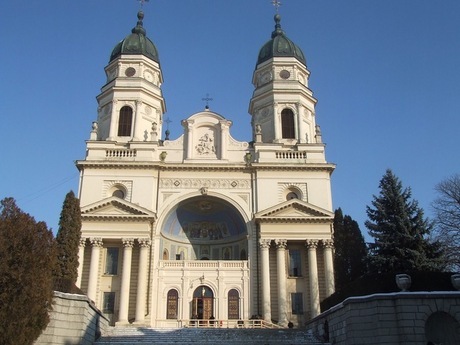St. Paraschiva Cathedral
Iasi, the capital of the province of Moldavia, has a population of about 400,000 and is situated in the north-eastern part of Romania. The city has many historical and architectural monuments and harbors the second largest university in the country, with and a student population of about 30,000. The Metropolitan Cathedral "Saint Parascheva" was founded by Veniamin Costachi, a Romanian educator and school organizer of the early 19th century.
The building was completed and consecrated in 1839, after 6 years of considerable efforts. Between 1880-1887 King Carol I of Romania (1866-1914) renovated, expanded, and redecorated the edifice, which is now the largest and the most beautiful metropolitan cathedral in Romania.
Inside the cathedral, in a silver coffin, lie the relics of Saint Parascheva. She is considered the Patron Saint and Protector of Moldavia and each year, on October the 14th, on the Saint’s Day, hundreds of thousands of people from all over the county and abroad come on a pilgrimage to Iasi to pray by her relics, and to ask the saint to intercede for them and their families. Her holy relics were brought to Iasi in 1641 by Prince Vasile Lupu.
In the Eastern Orthodox tradition there are three different saints known as St. Parascheva. Saint Parascheva was born in the village Epivat in Eastern Tracia, at the beginning of the XI-th century, in a family who believed in God. Then, by the age of 15, she dedicated herself to the monachal life. Currently, she is recognized mostly by the Orthodox Churches from Romania, Greece, Bulgaria, Russia and Serbia. Saint Parascheva’s relics were brought to Iasi in 1641, during the reign of the ruler Vasile Lupu, and they were exposed in the Church of the Three Hierarchs (Trei Ierarhi Church). People also call her Saint Friday. Saint Parascheva is considered the Protector of Moldavia and Bucovina, being the most popular of all the Saints whose relics are in Romania. Christians believe in the miraculous powers of the relics.
The Metropolitan Cathedral, Iaşi (Romanian: Catedrala Mitropolitană din Iaşi), located at 16 Ştefan cel Mare şi Sfânt Boulevard, Iaşi, Romania, is the seat of the Romanian Orthodox Archbishop of Iaşi and Metropolitan of Moldavia and Bukovina, and the largest Orthodox church in Romania. It is dedicated to Saint Paraschiva, to the Presentation of Jesus and to Saint George. Its form was inspired by the late Italian Renaissance style (Trinità dei Monti in particular), with Baroque elements dominating the interior and exterior decorative features. The Metropolitan Cathedral is listed in the National Register of Historic Monuments.
Two churches previously stood on the site: the White Church (15th century) and the Presentation Church (17th century). On 8 August 1826, prince Ioan Sturdza signed a decree ordering construction of the cathedral; Metropolitan Veniamin Costachi laid the cornerstone on 3 July 1833 and guided construction in its early years. Work began in 1833, using a neo-classical design by Viennese architects Gustav Freiwald and Bucher, and continued at a rapid pace until 1839, in the latter years under the Russian architect Mihail Singurov.
In 1840, after serious cracks had appeared on the large central arch, the brick ceiling was replaced with wood. On 23 May 1857, the central vault collapsed taking the interior columns with it, and the church remained unused for the next 25 years.
At the urging of Metropolitan Iosif Naniescu (1875-1902), the newly-independent Romanian state decided to resume work on the cathedral. A new cornerstone was laid on 15 April 1880. Alexandru Orăscu, rector of the University of Bucharest, designed new plans that added two rows of massive pilasters to the interior, creating a rectangular basilica shape, with a central nave and two smaller side naves. The four detached side spires were kept, but the large central dome was eliminated and replaced with a system of four semicircular sections, separated by transverse arches.
Gheorghe Tattarescu painted the icons and decorative elements in a style that respected Orthodox norms but also showed a Renaissance influence. The four Biblical scenes above the central nave, the saints' faces and the decorative compositions all show an Italian neo-classical rigor, to which the artist had been exposed during his studies at Rome's Accademia di San Luca. This creates harmony between the painting and the architectural style.
The stained glass was worked in Munich and redone after World War II, under Metropolitan Justinian Marina. Two valuable icons painted in the 16th century are kept inside; they depict Christ Pantocrator and the Madonna and Child. The eastern façade has six columns on a high stone base, above which is a high bas-relief of the Presentation. The western façade has eight columns separated by the entrance, above which is a curved mosaic also showing the Presentation; above that is a stone carving of Saint George. The roof is decorated with zinc fleurons and stylized crosses adorn both the roof and the four spires.
The cathedral was completed in 1887 and consecrated on 23 April that year in the presence of King Carol I and Queen Elisabeth, who had donated large sums for the project. In 1889, the relics of Saint Paraschiva, patron saint of Moldavia, were brought from Trei Ierarhi Monastery and continue to attract crowds of pilgrims, particularly on her feast day (October 14). These are located on the right side of the vestibule, as are those of Veniamin Costachi.




